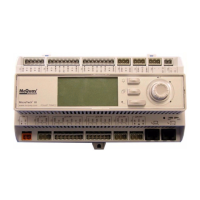102 McQuay OM 920-1
Operator’s Guide
The Degree Time Below Value and Degree Time Above value change whenever a stage
change occurs. If the previous stage change was a stage up and the number of stages increases
again, both Degree Time Above and Degree Time Below are set to zero.
If dehumidification is active, both Degree Time Above and Degree Time Below are set to
zero. If the previous stage change was a stage down and the number of stages decreases again,
both Degree Time Above and Degree Time Below are set to zero.
If the last stage change was a stage up and the stage decreases due to the Degree Time Below
exceeding the Degree Time Above, the Degree Time Below is reduced by an amount equal to
Degree Time Above and then the Degree Time Above is set to zero.
If the last stage change was a stage down and the stage increases due to the Degree Time
Above exceeding the Degree Time Below, the Degree Time Above is reduced by an amount
equal to Degree Time Below and then the Degree Time Below is set to zero.
Average Discharge Control Method Illustration
Figure 11 is an illustration of the “Average” compressor staging control method and is meant
to show a variety of staging possibilities not normal unit operation. Figure 11 shows nine
points on a graph of the discharge air temperature changing with time. The Cooling Interstage
Timer setting is 5 minutes.
Point 1 Assume that the controller has just staged up and that DTA and DTB are zero. As a
result, the discharge air temperature drops and the Cooling Interstage Timer is reset.
Point 2 DTA (Area A) equals DTB (Area B). The discharge air temperature is below the
Effective Discharge Cooling Set Point by more than half the Discharge Cooling Dead Band.
However, since the Cooling Interstage Timer has not yet expired, no staging action occurs.
Point 3 The Cooling Interstage Timer has expired. DTB (Area B + Area C) is greater than
DTA (Area A) and the discharge air temperature is below the Effective Discharge Cooling Set
Point by more than half the Discharge Cooling Dead Band. Therefore, cooling is staged down.
As a result, the discharge air temperature rises, the Cooling Interstage Timer is reset, and DTA
is subtracted from both DTA and DTB. This zeros DTA and leaves DTB equal to Area C.
Point 4 The Cooling Interstage Timer has expired. The discharge air temperature is above the
Effective Discharge Cooling Set Point by more than half the Discharge Cooling Dead Band.
However, since DTA (Area E) is not yet equal to DTB (Area C + Area D), no staging action
occurs and the discharge air temperature continues to rise.
Point 5 The Cooling Interstage Timer has expired. The discharge air temperature is above the
Effective Discharge Cooling Set Point by more than half the Discharge Cooling Dead Band
and DTA (Area E + Area F) is equal to DTB (Area C + Area D). Therefore, cooling is staged
up. As a result, the discharge air temperature drops, the Cooling Interstage Timer is reset, and
DTB is subtracted from both DTB and DTA. This zeros both DTA and DTB since they are
equal. Note that the elapsed time since the last stage change in Figure 11 is 6.3 minutes.
Point 6 The Cooling Interstage Timer has expired. Because the cooling load is now
increasing, the discharge air temperature does not fall below the Effective Discharge
Cooling Set Point by more than half the Discharge Cooling Dead Band. No staging action
occurs for two reasons: (1) the discharge air temperature is within the Discharge Cooling
Dead Band and (2) DTB (Area H) is not yet equal to DTA (Area G). Even if the discharge air
temperature falls below the Effective Discharge Cooling Set Point by more than half the
Discharge Cooling Dead Band (as shown just after Point 6), a stage down does not occur
because DTB remains less than DTA. The discharge air temperature starts rising again because
the load is increasing.

